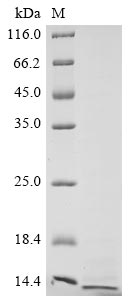This recombinant avian infectious bronchitis virus Non-structural protein 3b (3b) gets expressed in E. coli and contains the complete sequence spanning amino acids 1-64. The protein carries a C-terminal 6xHis-tag, which makes purification and detection more straightforward. SDS-PAGE analysis shows purity levels exceeding 85%, suggesting it should work reliably in research settings. This product is meant strictly for research purposes and cannot be used in therapeutic or diagnostic procedures.
Non-structural protein 3b (3b) from avian infectious bronchitis virus appears to play an important role in how the virus completes its lifecycle and replicates. Since it's involved in viral pathogenesis, researchers study this protein to better understand viral mechanisms and how viruses interact with their hosts. Work on protein 3b may help build a clearer picture of viral replication strategies and could inform efforts to develop interventions against avian infectious bronchitis.
Potential Applications
Note: The applications listed below are based on what we know about this protein's biological functions, published research, and experience from experts in the field. However, we haven't fully tested all of these applications ourselves yet. We'd recommend running some preliminary tests first to make sure they work for your specific research goals.
Based on the provided information, the recombinant IBV non-structural protein 3b is produced in an E. coli expression system, has a purity of >85% by SDS-PAGE, and includes a C-terminal 6xHis tag. However, there is a high probability that this protein is not correctly folded or bioactive. The E. coli system lacks the eukaryotic machinery for post-translational modifications and chaperones, which are often critical for viral proteins to achieve native conformation. While non-structural proteins like 3b may have simpler folding requirements, the absence of validation data (e.g., circular dichroism for secondary structure or functional assays) means folding cannot be assumed. Thus, without experimental proof, the protein is likely misfolded and inactive for applications requiring native structure.
1. Antibody Development and Characterization
This protein is suitable as an immunogen for generating antibodies targeting linear epitopes, as antibody development often relies on amino acid sequences rather than native folding. The 85%
+ purity is acceptable, but contaminants might induce non-specific antibodies. However, if antibodies are intended to recognize conformational epitopes of the native 3b protein (e.g., in immunofluorescence or neutralization assays), misfolding could render them ineffective. The His-tag simplifies purification but may also elicit tag-specific antibodies.
2. Structural and Biophysical Analysis
The protein is unsuitable for structural studies without confirmation of correct folding. Techniques like circular dichroism or dynamic light scattering could be applied, but data from a misfolded protein would not reflect the native structure of 3b. The E. coli expression system increases the risk of aggregation or non-native conformations, making results unreliable for understanding biological function.
3. ELISA-Based Detection Assay Development
This recombinant protein could be used in ELISA for detecting antibodies against linear epitopes, as the His-tag facilitates immobilization. However, if the assay aims to detect antibodies that recognize conformational epitopes (e.g., for serotyping or neutralization studies), misfolding would reduce sensitivity and specificity. Consistency might be affected by batch-to-batch folding variations.
Final Recommendation & Action Plan
To ensure reliable outcomes, prioritize experimental validation of protein folding and bioactivity before any application. Start with biophysical techniques (e.g., circular dichroism to assess secondary structure and size-exclusion chromatography to evaluate oligomeric state) to confirm folding. If resources allow, develop a functional assay—though challenging for non-structural proteins like 3b, interaction studies with known partners (e.g., other viral proteins from infected cells) could serve as a proxy. If validation fails, restrict use to linear-epitope antibody production or as a negative control in folding studies, clearly disclosing limitations in research communications.






